While content marketing keeps growing in popularity, simply creating blogs and social media posts is not enough to impact the bottom line.
To succeed in content, you need to build a comprehensive and holistic strategy. Ultimately, it will allow you to attract and engage a clearly defined audience and, in the end, generate profitable customer action.
By following the in-depth guide below, you will map out the primary steps needed to develop a robust content marketing strategy for your business.
What Is a Content Marketing Strategy
A strategy is a plan for getting where you want to go. So, what specifically is a content marketing strategy? Let’s distinguish it from a few similar industry terms:
Content marketing strategy: This high-level strategy deals with mapping out the implementation and distribution of your brand’s content marketing materials. Content plan: You will sometimes hear this referred to as a “content calendar.” A content plan helps you organize your material implementation in a neat and orderly fashion.Why Do You Need a Content Marketing Strategy
We found out that 40% of businesses don’t have a documented strategy yet. But why is it important to map out and document your content marketing strategy?
It helps you move from chaotically creating content to building an organized system with specific goals, success metrics, and processes for continuous improvement.
Out of the 1,500 marketers we surveyed for our State of Content Marketing report, 78% who felt their content marketing strategy was exceptionally effective in 2021 had documented their strategy.
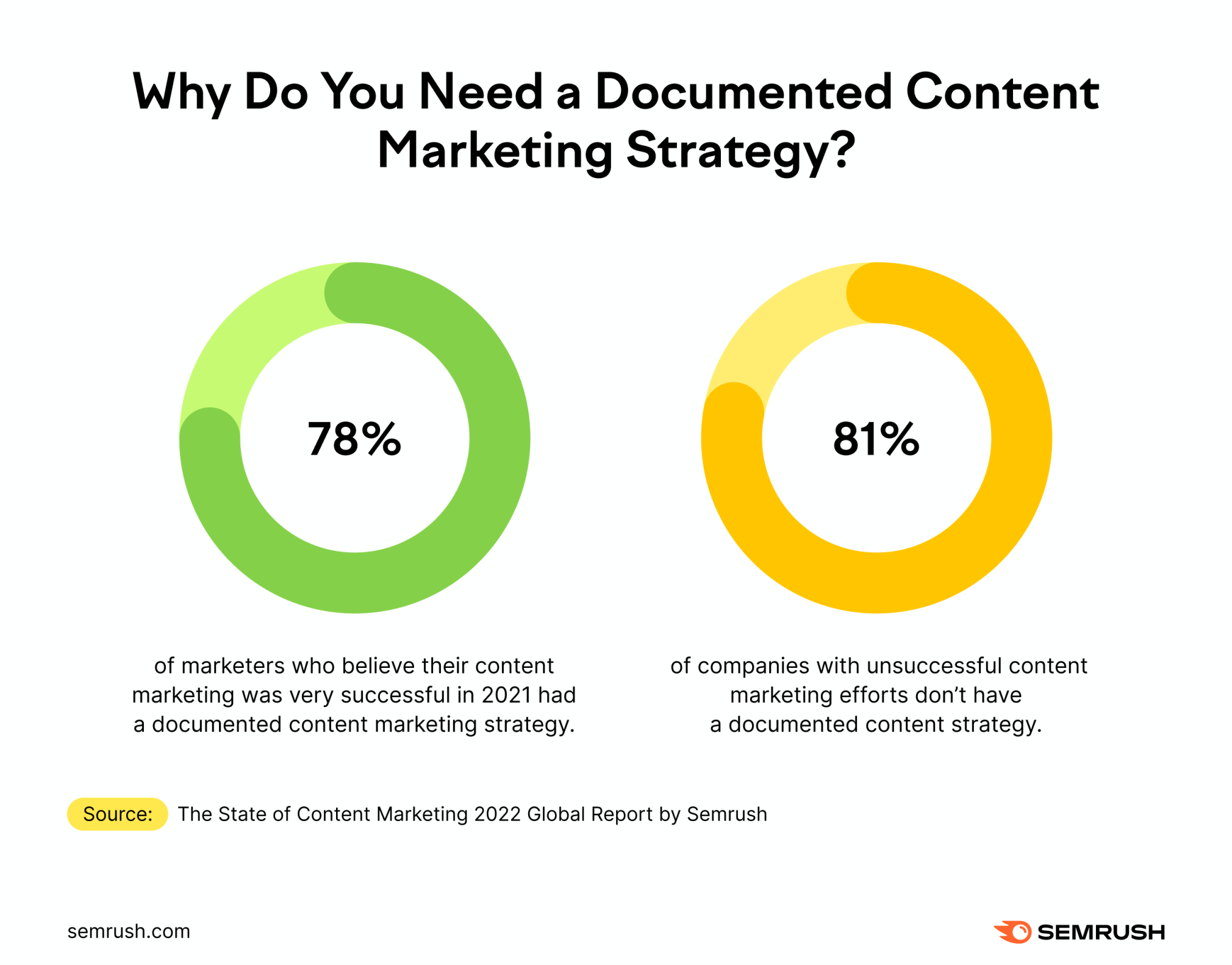
The 5 Elements of a Powerful Content Marketing Strategy
An effective Content Marketing strategy should have these five core elements to be successful: audience personas, brand positioning, owned media value proposition, business case, and an action plan. Let’s see why these elements are essential and how you can start implementing each of them.
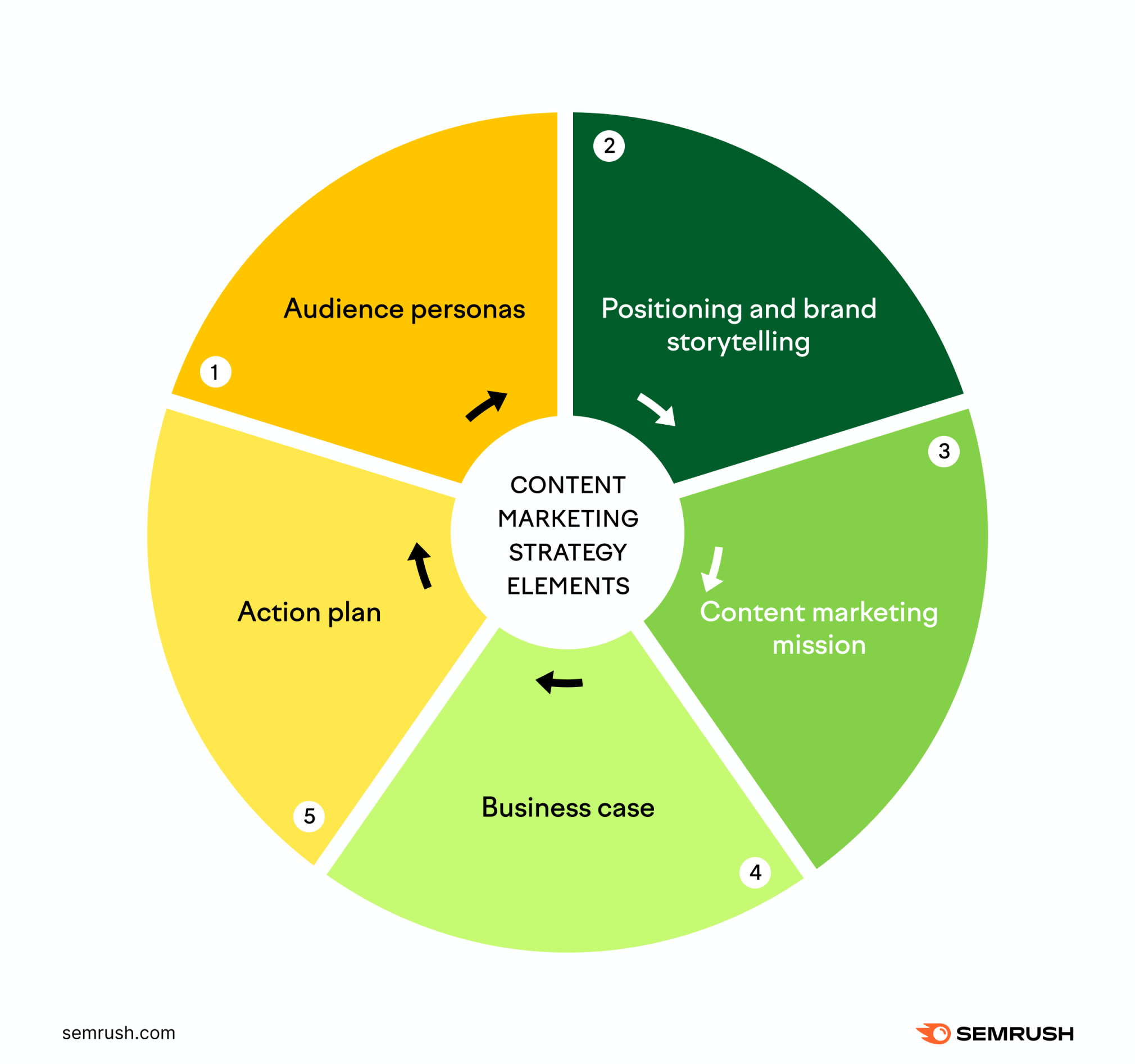
1. Audience Personas
You can’t really tell the story of your brand if you don’t know who you are telling your story to. That’s why your first step will be to identify the audience you are attempting to target with your content. There are multiple ways to do this:
Survey your existing customers Research industry trends Know who you aren’t trying to target Keep close tabs on whom your competitors are targetingOnce you have your audience in mind, you can use our free Personas tool to put them into writing.
You’ll want to be able to clearly and succinctly communicate who your audience is to all stakeholders and anyone involved in brand messaging.
Start by exploring these persona examples for your inspiration.
2. Positioning Your Brand and Story
A clearly defined brand and product positioning will help you provide a consistent experience for your audience and build the right image through all your content marketing channels.
These questions will help you brainstorm your positioning in the market:
Who are my existing and potential customers, and what are their goals? Who are my top competitors, and how do they market their brands? What is my brand’s unique value? What problems does my product help to solve? What makes it a better choice over my competitors?Use this information to shape the main pillars of your brand story.
A brand story is a summary of your company’s history, mission, purpose, and values. It can help you choose the right direction in your content marketing strategy, identifying to right messages and topics to translate with your content.
Focus on the following elements:
The hero of your story (your customer) and their goals and challenges Your brand’s personality The purpose of your brand and key brand values The way your product and your content can help reinforce all the above and empower your heroUse this free brand storytelling template to complete this step and document your efforts. This step can be especially beneficial for small businesses and startups that can leverage their unique backgrounds and identities.
3. Content Marketing Mission Statement and Owned Media Value Proposition
To establish your brand as a credible content publisher, define your owned media value proposition. It'll help you find a differentiation point in your content strategy and compete more effectively. To do so, answer the following questions:
What unique value do you provide to your audience with your content? How do you stand out from other content creators? Why should readers choose to follow your content channels?Another important item to include in your strategy is your content marketing mission statement. It should summarize why you are creating content and provide information on who can benefit from it.
Make sure your content marketing mission statement includes the following elements:
The audience you are creating your content for Their goals and how your content will help achieve thoseFor example, 'Our content is where digital marketing managers find multimedia information about SEO and content marketing so that they can help their companies grow via organic channels.'
4. Business Case and Content Marketing Goals
Providing value to your audience is an integral part of a successful content strategy. But in addition to attracting new readers and followers, content marketing should drive your business forward.
Identify business goals your company needs to achieve and figure out how content marketing will bring your company closer to those goals. How many resources do you need to invest in your content strategy and what results do you want to generate?
A documented business case will help you better understand the benefits, costs, and risks of implementing a content marketing strategy in your company and convince the decision-makers of its value for the company.
5. Action Plan
Finally, you will list out your main content marketing campaigns and projects on deck for the year and add them to your content plan. Think about how they will achieve the content marketing goals you’ve previously set for your business.
Doing this will allow you to think through each content strategy step. Make sure to include the following information:
Content formats you want to focus on High-level content topics and campaigns Channels for content distribution and promotionTo decide on your optimal content formats and channels, you’ll need to look at your historical content performance and further analyze your audience, which we’ll discuss later.
We have listed the main elements to include in your content strategy. Now, let’s see how you can build it and develop effective content step by step.
7 Steps to Creating a Complete Content Strategy
Long-term planning allows you to anticipate challenges and allocate resources effectively. Laying out these seven steps will help you develop and implement a content strategy aligned with your marketing and business goals.
As mentioned earlier, you must document your plan. This could be a slide deck, a Google document, a spreadsheet, or another format that works well for your business model and can be easily shared with all essential stakeholders.
Step 1: Determine Your Audience and the Story You Want to Tell with Your Content
The best starting point for your content strategy, or any other marketing strategy, is your target audience.
While your buyer personas will form the base for your content strategy, your audience isn’t solely made up of buyers. Audiences include people who begin interacting with your brand long before they intend to make a purchase.
It is essential to deliver content that will attract your potential customers before they enter the buyer journey.
First, draw them into the universe your brand has created. Then, follow up with content that illuminates how you can be of assistance when they are ready to take action.Besides, becoming a valuable source of information can help you build a community of brand advocates who will spread the word and strengthen your thought leadership.
We sometimes call these people “reader personas", highlighting that it’s all about delivering value to your audiences vs. pushing your products or services.
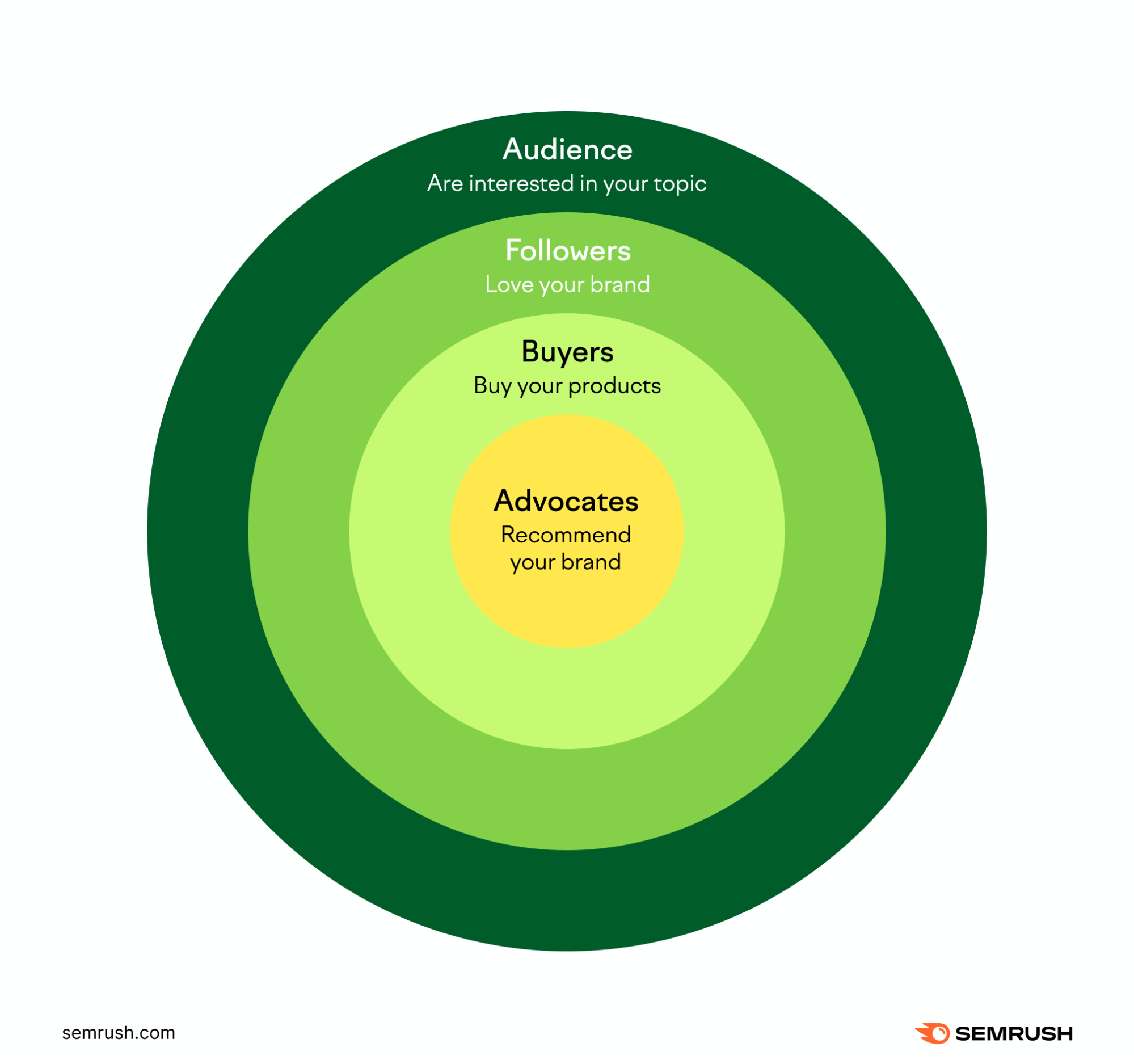
Red Bull is an excellent example of a brand that creates content for audiences, not buyers. Red Bull’s owned media doesn’t focus on its product; it covers topics the audience is interested in, like extreme sports and once-in-a-lifetime experiences. You can easily identify the target audience—young and adventurous people, passionate about sport and an active lifestyle.
These content offerings help them identify with the brand and encourage loyalty that stretches far beyond buying their drinks.
Red Bull is a media company that happens to sell energy drinks.
Dietrich Mateschitz
Red Bull showcases the importance of integrating your brand story into every content piece and every message sent to your audience. Remember about your mission, where you stand, and why you are sharing content in the first place. Creating this unique voice and character can help you stand out in the age of “content shock.”
Keep reading to explore some audience research frameworks to help you build resonating content experiences.
The Empathy Map
The empathy map is a collaborative tool that allows you to understand your target audience better. Alexander Osterwalder and Yves Pigneur describe this method in their book “Business Model Generation.”
The empathy map is based on a comprehensive approach: By adopting your customers’ perspective or point of view, you can step back and improve their experience based on what they think, feel, see, or hear.
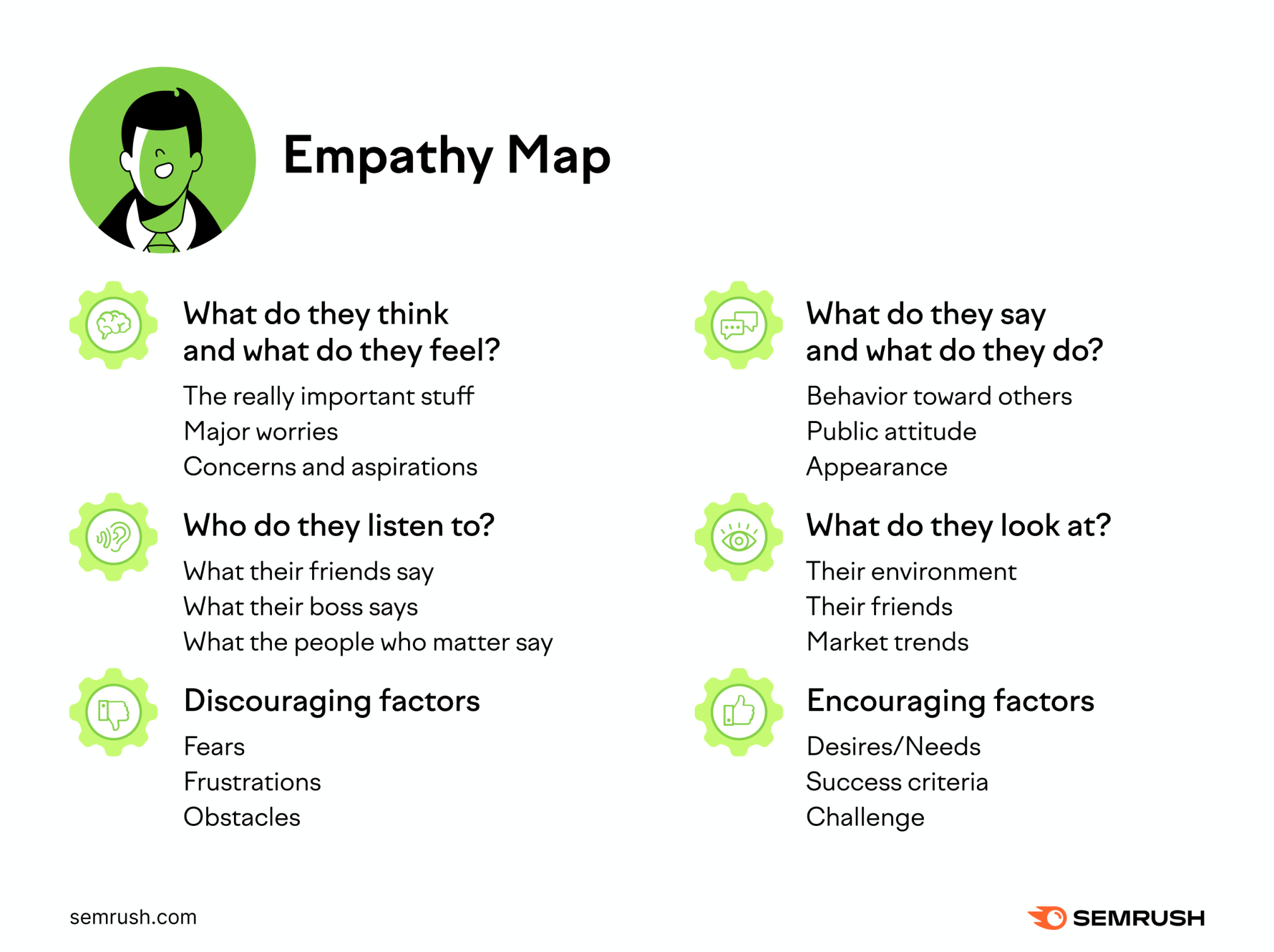
Using this framework can help you better understand your customers’ pain points and buying behavior.
The “Jobs to Be Done” Framework
The “Jobs to Be Done” framework is an easy way to understand your customers’ needs and to find the reason they might turn to your brand. It organizes your entire content marketing strategy from the jump.
The idea is to place yourself in the prospect’s shoes and identify the jobs your customer is trying to complete (what your customer seeks to accomplish in a given circumstance).
As the prospect, try to complete the following sentence:
When I ___ , that’s why I want ___ , so I can ___ .
“When I___” is the problem of your potential customer. “That’s why I want ___” is the solution you can offer them. “So I can ___”is the prospect’s need (a state or a result they want to achieve).For example: When I work, I spend too much time completing all my tasks, that’s why I want to find a tool to improve my time management, so I can spend more time with my family.
In this example, “a tool to improve time management” is what you sell, and “more time with family” is what the customer buys.
Keep in mind that your prospects don’t need your product and content as such; they are looking to improve their personal or professional lives by solving their problems.
People don’t want to buy a quarter-inch drill, they want a quarter-inch hole.
Theodore Levitt
Once you have an understanding of the prospect’s current problem, the solution they need, and the result they envision, you can create compelling content that can transform them from newcomers into your brand advocates.
Step 2: Analyze Historical Content Performance and Establish Your Content Marketing Goals
Follow this path to establish your content marketing goals:
Zoom out and think about your company’s high-level business and marketing objectives. For instance, you might want to become a number solution for improving time management and have a specific marketing revenue goal for this year. Consider how content can contribute to these bigger goals, which are usually specific to your business. Identify the content marketing metrics that matter to you: What will success look like in numbers? Remember to define a particular success metric for every content piece you are planning to create.Such metrics might be primary: e.g., revenue generated by content marketing or organic traffic and the number of leads. Others might be secondary: e.g., organic traffic, ranking, and shares.
To establish a benchmark, analyze your analytics dashboards (e.g., in Google Analytics) and examine how your content has been performing against those goals.
Remember that we all live in a world of limited resources. Your goals and plans are closely tied to the available budget and capacity of your team. So, make sure to take this into account when setting your targets.
According to our research, brand awareness, attracting traffic, and generating leads remain the key content marketing goals in 2022.
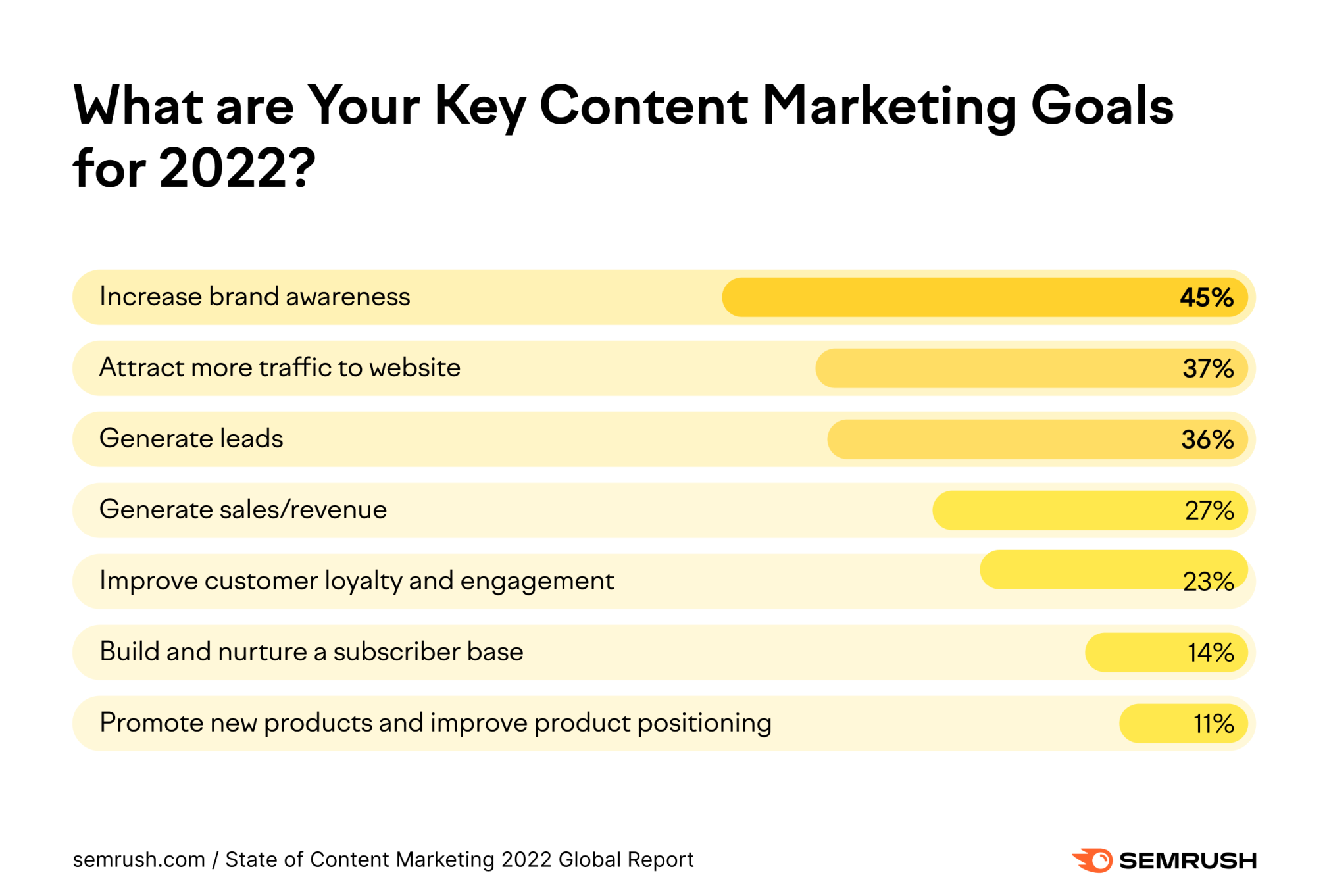
But we encourage you to always look at the bigger picture and see content marketing as an integral part of your overall marketing strategy. An example of an overarching goal could be: “In 2022, we want to achieve a 20% increase in revenue created by organic content and generate 15,000 MQLs with a budget of $30,000.”
Pro tip: Take the buyer’s journey into account when setting your content strategy goals. For example, in B2B, the sales cycle tends to be much longer than in B2C. So, multitouch attribution would be more optimal when analyzing your content performance and defining your KPIs (key performance indicators).
Keep reading to discover some goal-setting frameworks that can help you complete this step.
Goal-Setting Frameworks
Let’s look at some progressive goal-setting frameworks that can help you at this step. While you may be more comfortable with traditional goal-setting frameworks like SMART (Specific, Measurable, Achievable, Relevant, and Time-Bound) goals, flexibility is key to setting realistic benchmarks. Consider using the framework CLEAR, which can help you become more agile in a fast-changing environment.
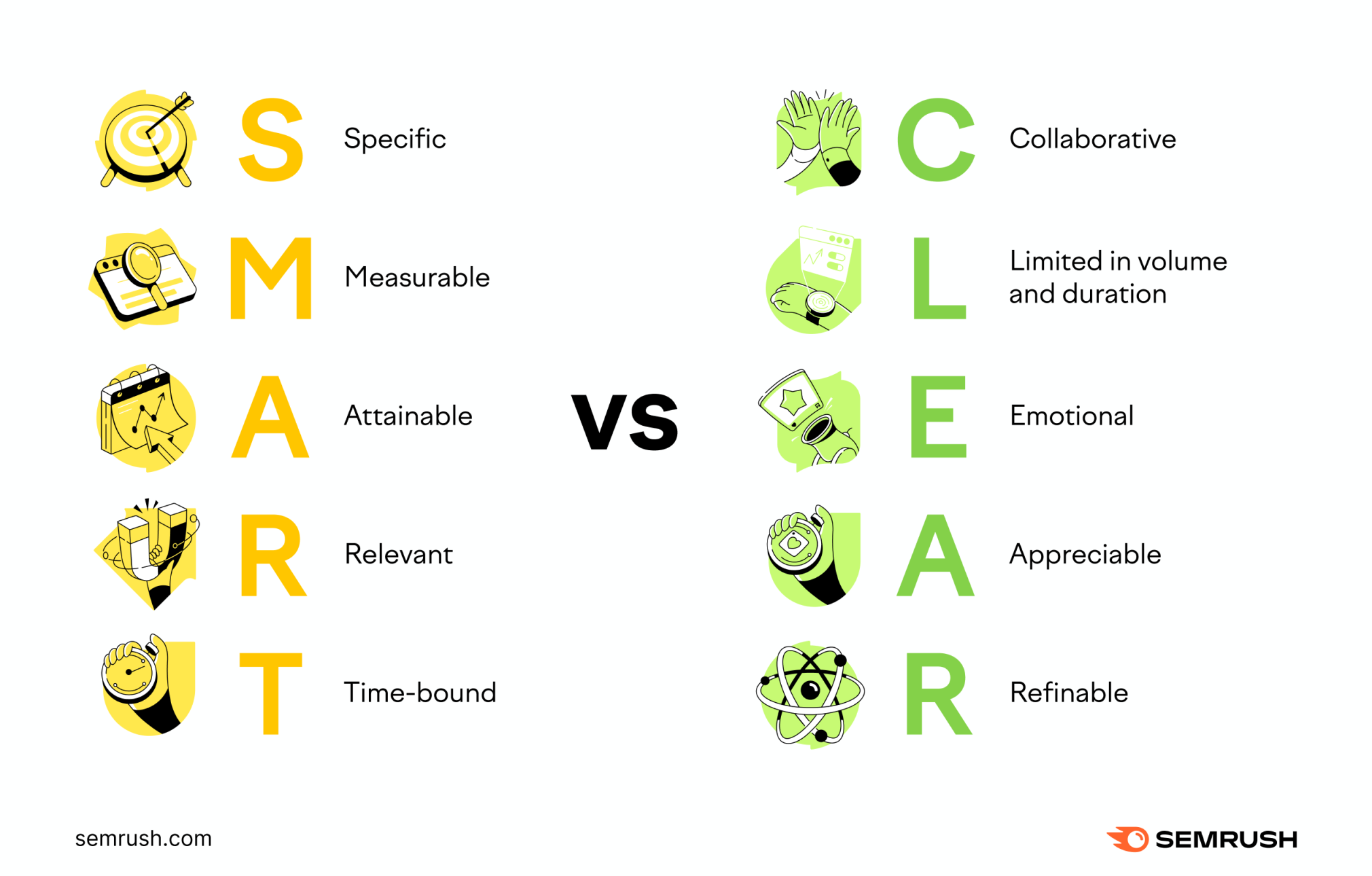
Your CLEAR objectives are evaluated in terms of their main characteristics:
Collaborative: Your goals encourage teamwork Limited: They are limited in scope and duration Emotional: They inspire and motivate your team Appreciable: They are broken down into smaller micro-objectives Refinable: They can be redefined according to circumstances and needsBesides, if you find KPIs to be too technical or limited in scope, set OKRs (Objectives and Key Results) to make your goals more flexible:
Set each goal as a challenge Define three to four key results by objective Measure your goals with a progress indicator of 0-100% Make your goals collaborative and transparent Assess goals according to new conditions Adjust a goal if it becomes irrelevant (even if you didn’t anticipate it)With this approach, you can target an ambitious result, but set a minimum threshold for reaching the goal. Progress indicators (0–100%) allow each team member to see how attainable each goal is and understand what remains to be accomplished.
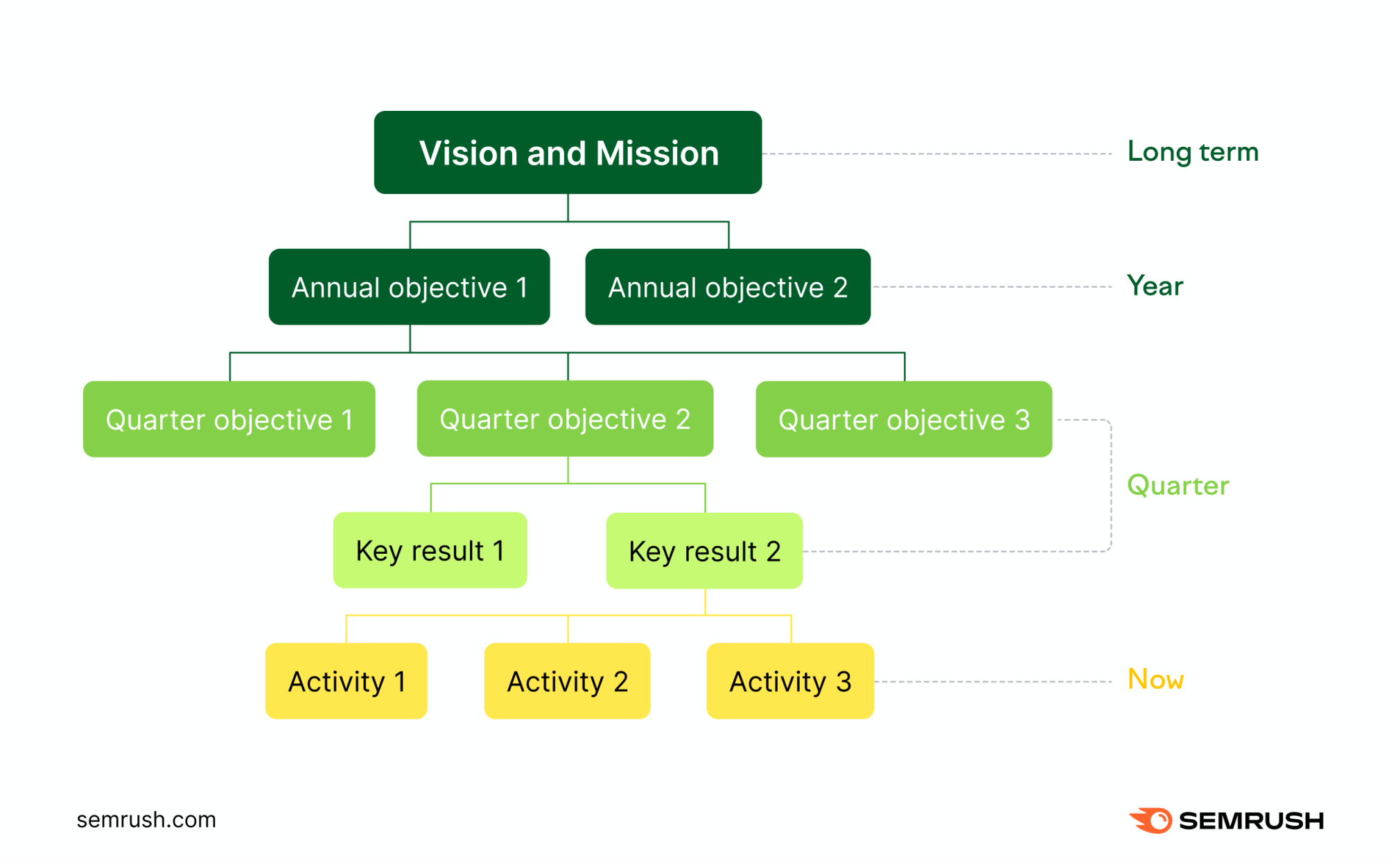
In contrast to KPIs, which can be reset only for each new quarter, objectives in OKRs can be updated at any time if initial conditions change. With OKRs, you will not waste your time working on goals that are no longer relevant to you.
Step 3: Audit Your Existing Content
In a nutshell, a content audit is a process of organizing, analyzing, and improving your existing content. It can help you get the most out of your existing pages while potentially saving resources.
It’s also essential to better understand what content resonates with your audience, from topics to formats.
According to our research, 65% of companies with very successful content marketing in 2021 ran content audits at least twice a year. Generating more organic traffic, ranking higher, and boosting engagement are some of the main benefits of a content audit.
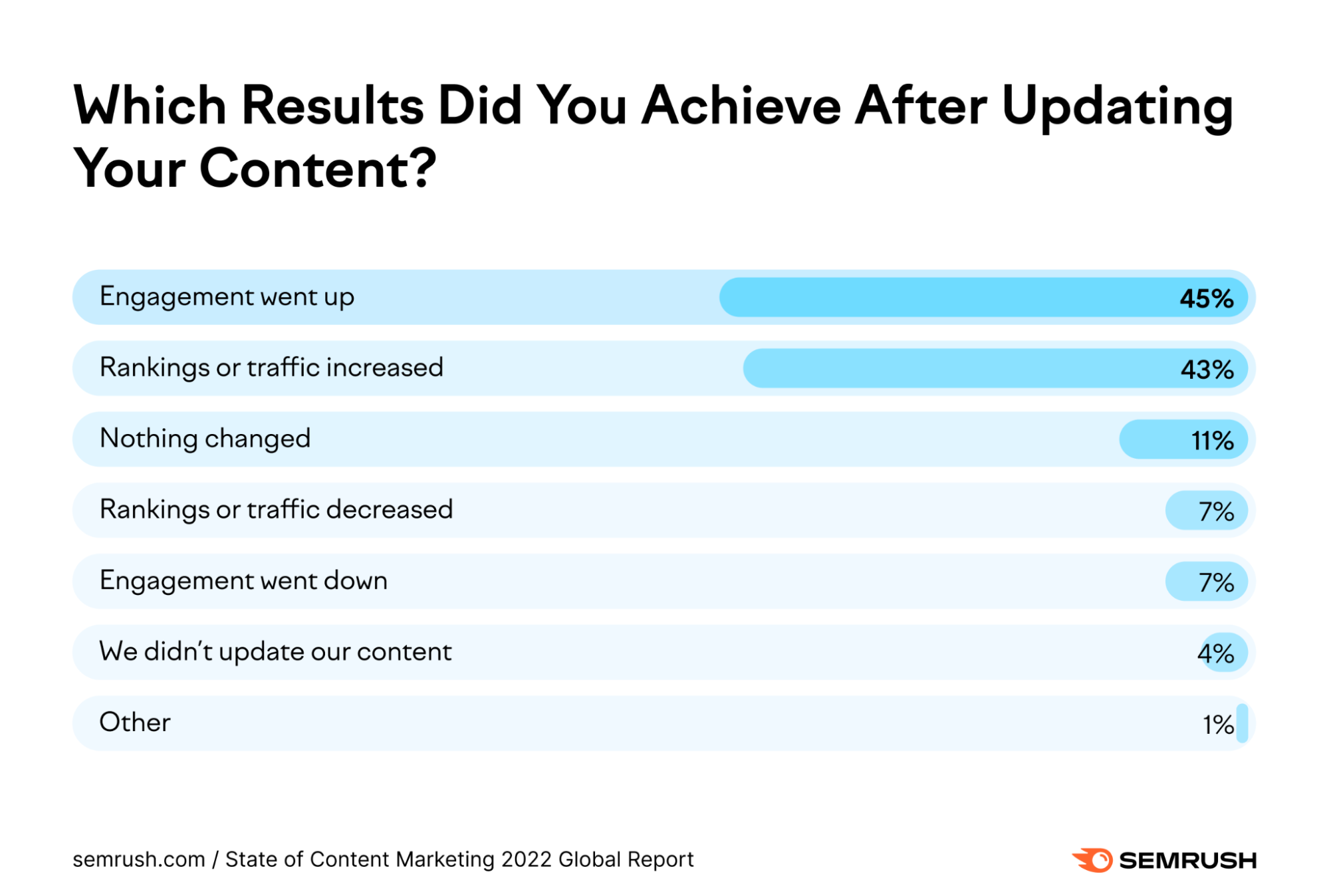
Use the audit to answer the following questions:
Which content topics and keywords seem to be working best? Which formats generate the most engagement and conversions? Which channels drive the most traffic?Use the Content Audit tool to run automated content audits on your website.
Step 4: Develop a High-Level Editorial Plan and Content Calendar
Planning your content allows you to allocate your resources appropriately, see which workflows are taking longer than expected, and adjust your expectations accordingly.
Prioritize Your Actions
One of the essential elements of efficient planning is prioritization. If you plan your actions, you can identify the most critical tasks or things that you can easily test.
By doing this, you protect your strategy from major failures and find opportunities for experiments that can potentially boost your results.
You can choose to prioritize in multiple ways, including:
Potential gains The flow of the campaign you are creating What resources you’ll need to create your campaigns Product or service launchesBased on that, you can decide which campaigns, topics, and formats should go first in your plan.
Find Relevant Topics
Start by looking at the big picture. What big themes do you want to cover this year? Maybe you want to tackle large, integrated campaigns.
For instance, a company offering a time management app might want to focus on such high-level topics as productivity and work-life balance. This information should come from your audience research insights, as well as competitive research.
Try generating a list of themes that are likely to stay effective and relevant long-term. When making a decision on whether a topic is worth pursuing, assess it across the two main dimensions:
Its usefulness for your target audience Its ability to impact the bottom lineThere are several tools you can use to automate and enhance this process. One of them is the Topic Research tool that gives you ideas for subjects to cover, as well as related questions, possible subtopics, and headers.
You might focus on creating evergreen content, building topic clusters, or leveraging newsjacking—the tool will suggest ideas for either of those strategies.
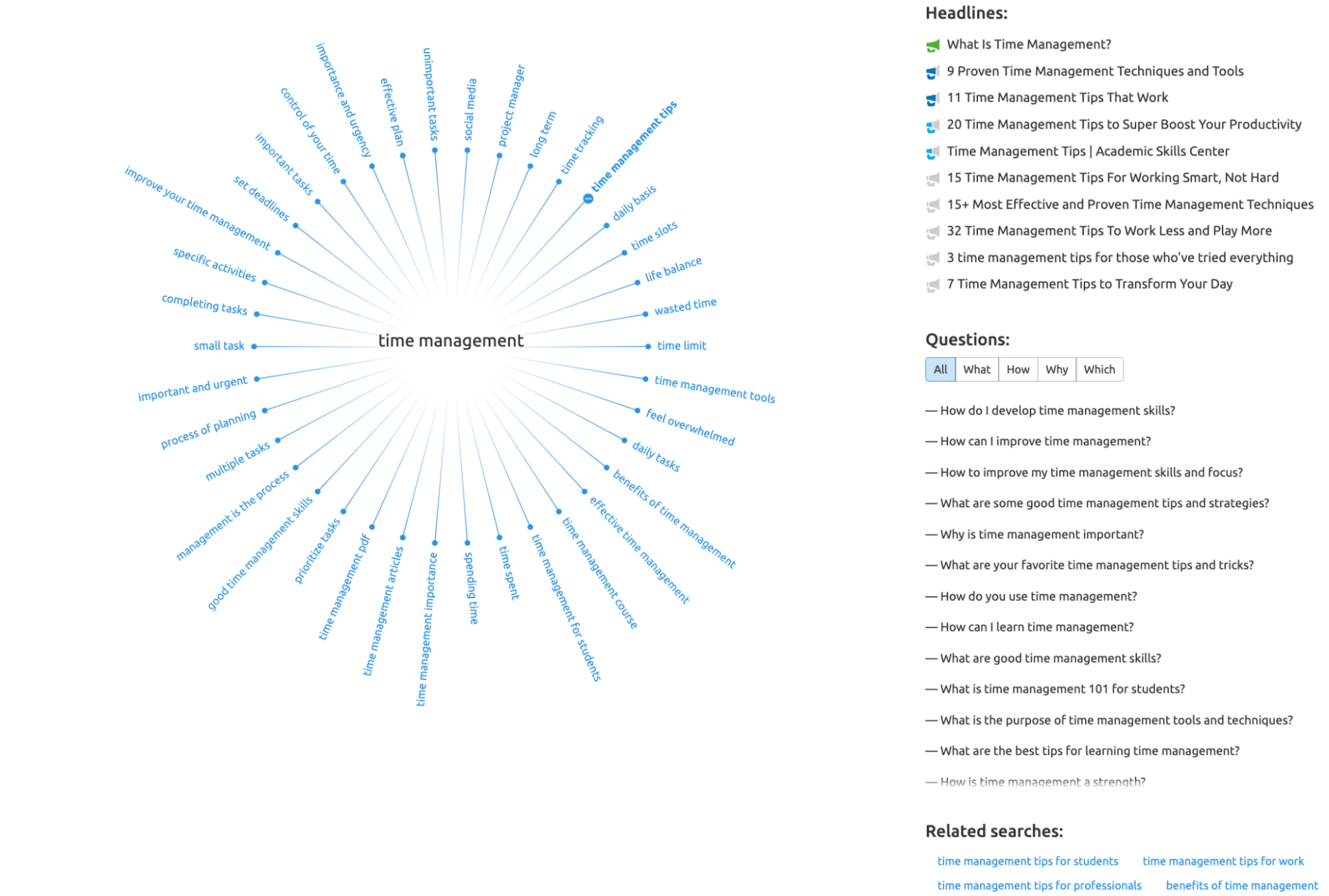
Once you’ve created a list of topics, move to full-scale keyword research using the Keyword Magic Tool. Each topic might have several related keywords, which can then help you design your topic clusters.
Build Topic Clusters
Building topic clusters is one of the most effective ways to organize your content.
Topic clusters are collections of inter-related content, with one central term covered on a pillar page and multiple related subtopics.
This organized approach is especially helpful if you have lots of content for users to navigate and want to build authority on a certain topic.
For example, if you are a company offering SEO services, you could devote a pillar page to SEO and create multiple related cluster pages on such topics as 'local SEO', 'technical SEO', 'backlinks', etc.

Once you have determined the right topics for your content hubs, place them on a content calendar to make tracking upcoming and missed deadlines easier.
Competitive Research
You’ll also want to know what your competition is doing. Find the topics, keywords, and content formats that work well for them.
Use this free Competitive Content Analysis Template to complete all the necessary steps to discover:
Positioning of your competitors Their tone of voice and target audience The main content formats they are using (e.g., blogs, podcasts, video) Main content categories they cover Primary keywords they target (using the Keyword Gap tool) Their top-performing content (using the Organic Research tool)Pro tip: Too often, brands focus on their market rivals and don’t pay enough attention to other content creators. When researching your competitors, include all publishers in your area of expertise, even if you don't compete on the actual market.
Make sure that unbranded media, like online magazines, industry blogs, or influencers’ video channels, are a part of your competitive research. This will help you see the bigger picture and get a better understanding of what's trending in your niche.
If you are not sure which websites to analyze, simply type your domain in the Organic Research tool for a list of all websites competing in your niche.
 Here are sample competitors for Purina - a brand offering pet food and related products
Here are sample competitors for Purina - a brand offering pet food and related productsDesign Your Content Funnel
Before starting the content creation process, think about the purpose of each piece you want to produce. Make sure that your content covers every part of the customer journey since the needs of your audience will differ significantly depending on each stage.
Start by mapping out your content marketing funnel. Consider creating content for each stage:
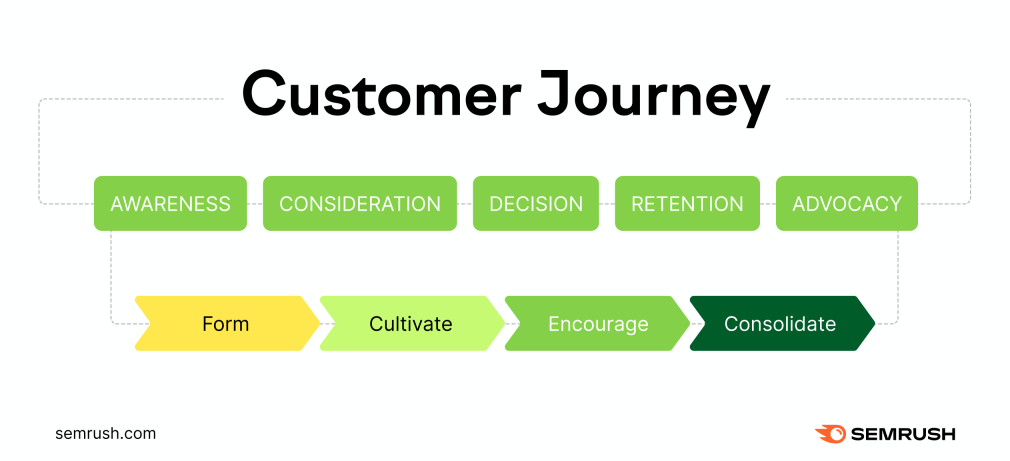 Awareness: Center these pieces around questions your leads may have at the top of the funnel as they become more aware of their problem or need; this content can also tell your brand story, educate, inform, or entertain your audience. Thought leadership content, for example, works great at this stage. Consideration: As they progress through the consideration stage, prospects will want to know more about the way to solve their problem. Help them understand why they need assistance in overcoming the issue in front of them; guide them through how others have solved similar problems in the past; and discuss what steps may be necessary to follow up. Decision: These pieces are designed to help potential leads determine why you are the best choice to help them. Case studies, client reviews, and other content showcasing the work you have done in the past can be helpful at this stage, as users compare you directly with other providers. Retention: Bring to the forefront the various ways to get the most out of your product or service, as well as ways to solve common issues and new features. Anticipating their questions and addressing them preemptively can also keep prospects from growing frustrated with your offerings. Advocacy: These are pieces that highlight the parts of your brand that will transform customers into evangelists; this might include pieces that spotlight your corporate values, efforts to give back, or outstanding team members.
Awareness: Center these pieces around questions your leads may have at the top of the funnel as they become more aware of their problem or need; this content can also tell your brand story, educate, inform, or entertain your audience. Thought leadership content, for example, works great at this stage. Consideration: As they progress through the consideration stage, prospects will want to know more about the way to solve their problem. Help them understand why they need assistance in overcoming the issue in front of them; guide them through how others have solved similar problems in the past; and discuss what steps may be necessary to follow up. Decision: These pieces are designed to help potential leads determine why you are the best choice to help them. Case studies, client reviews, and other content showcasing the work you have done in the past can be helpful at this stage, as users compare you directly with other providers. Retention: Bring to the forefront the various ways to get the most out of your product or service, as well as ways to solve common issues and new features. Anticipating their questions and addressing them preemptively can also keep prospects from growing frustrated with your offerings. Advocacy: These are pieces that highlight the parts of your brand that will transform customers into evangelists; this might include pieces that spotlight your corporate values, efforts to give back, or outstanding team members.To further excel at creating content for specific customer journey stages, download this free Content Mapping Template Kit.
Use an Editorial Calendar to Organize Your Work
Creating a content calendar is the most effective way to organize all the information gathered in the previous steps. Use it to plan content marketing campaigns, design topic clusters, and execute content production.
Some of the key elements to include in your calendar are topics or keywords, target dates, headlines, categories or clusters, content formats, target personas, and success metrics, among others.
Download this free Content Calendar Template Kit to complete this step.
You can also use the Semrush Marketing Calendar tool, which works as a collaborative editorial calendar. It allows you to monitor progress in real-time and integrates with Google Analytics.
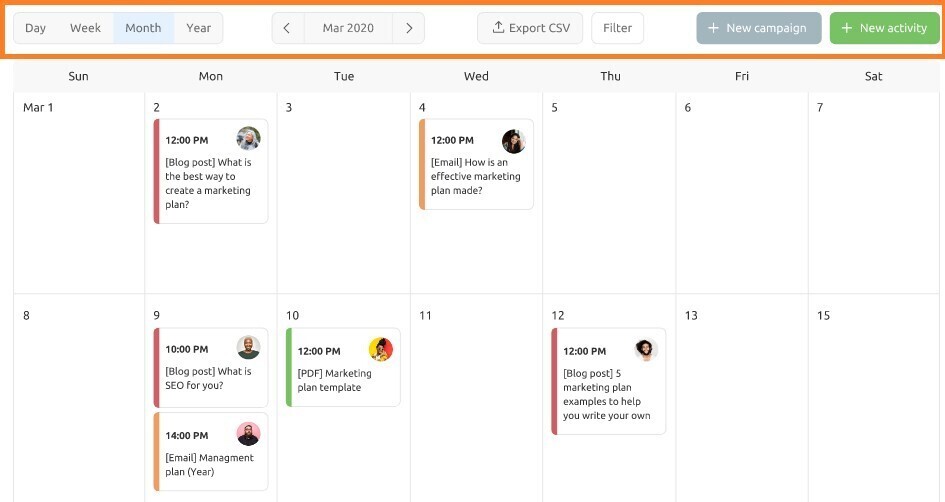
Make sure to share your content calendar across the entire company. Ideally, you should actively involve other teams in enhancing and improving the calendar. For instance, engaging customer-facing teams (e.g., sales) and encouraging them to add their ideas can make your content more customer-centric.
It can help position the (content) team not as a ‘group of writers and grammar enthusiasts’ but as a critical part of the company’s pipeline and revenue-building engine.
David McCarthy, Chicago-based Content Marketing Strategist
Plan Content Production
Try to come up with ways to make content production more effective upfront. You’ll create better content with less chaos. At the content strategy planning stage, think about some high-level solutions that can improve your content production cycles and save you resources. Start with:
Examining your available resources (e.g., content budgets, content team members, etc.) Mapping out the approximate timeline and cadence (e.g., how many content pieces you plan to produce monthly) Finding potential bottlenecks and opportunities for optimization (e.g., would working with internal subject matter experts help you with content research?) Assessing the budget and time needed to produce content to meet your goals Deciding whether you will outsource content production or keep it in-house Determining whether you need design, development, or any other teams to be involved at the production stage.When it comes to your timeline, it should depend on your specific KPIs and expectations. For instance, estimate the number of keywords you need to cover in your blog this year to achieve your organic traffic goals.
If you don’t blog often that isn’t a bad thing; blogging randomly here and there is terrible. The biggest mistake is committing to a specific frequency, then not delivering on your promise to your audience.
Andy Crestodina, Chief Marketing Officer and Co-Founder of Orbit Media Inc.
Step 5: Develop Your Content
The quality of your content should come before everything else, including your desire to rank faster and produce more. Use the following strategies to help you create effective and memorable content that resonates with your audience.
Focus on Originality
It’s a harsh truth but one worth mentioning: If your content isn’t original, it’s highly unlikely to capture the attention of your intended audience. Your best bet is to invest in people and resources that can help you do unique research, come up with original ideas, and execute those ideas into highly enticing content.
The content marketers who will continue to stand out are those with the most intimate knowledge of their (niche) audience. They are the original thinkers, the creative writers, the experimenters, the people with the skills to captivate, educate, entertain, and inspire their audience.
Henneke Duistermaat, Founder at Enchanting Marketing
Avoid publishing content that is exclusively based on your analysis of other pages talking about the same topic. Take a step further and work on including your unique experience, data, research, and opinion in every content piece. This will help build credibility and trust with your audience, creating a foundation for your organic growth.
This is especially true for such niche YMYL (Your Money, Your Life) sectors as healthcare, real estate, finance, and legal.
Diversify Your Content
Some content types work better at specific stages of the funnel; others are more preferred by a certain audience. The ideal solution is to include a diverse mix of content formats to appeal to every member of your audience. The selection will depend on your customers’ preferences and on your analysis of content performance.
This graphic breaks down a few options you might want to include in your content strategy:
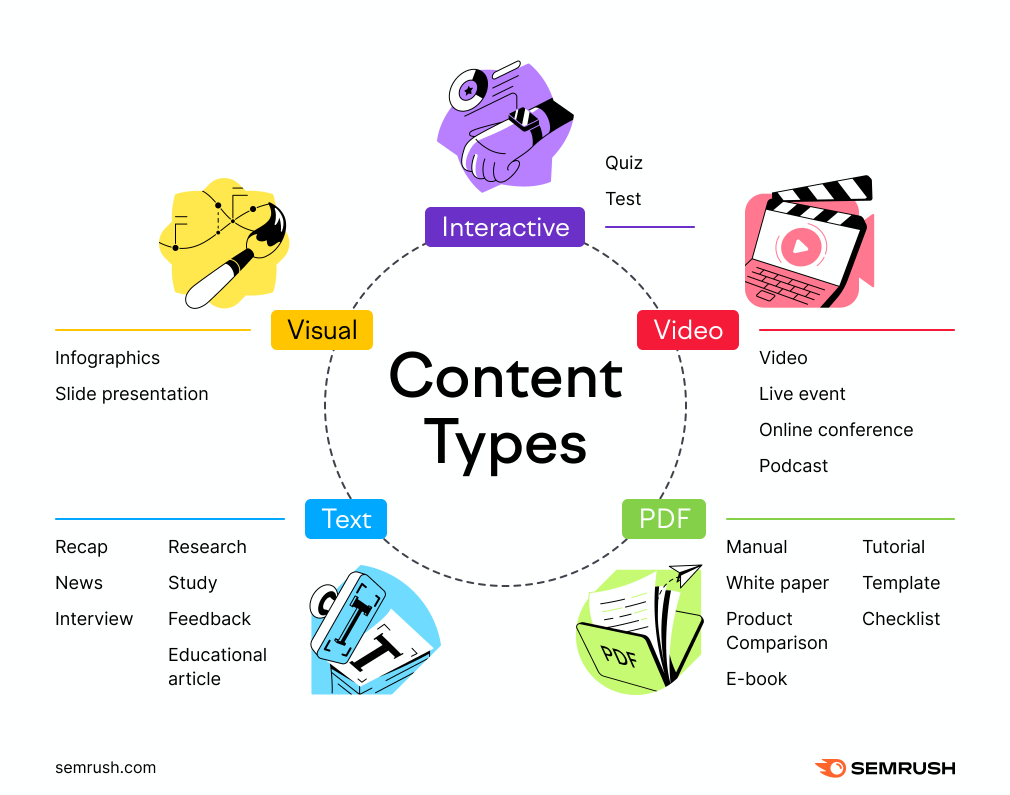
Remember that you don’t have to employ every content type out there. On the contrary, we recommend you only focus on those formats that resonate with your audience and make sense within your content funnel. According to our survey of 1,500 marketers, video and blog posts were the top two content formats in 2021.
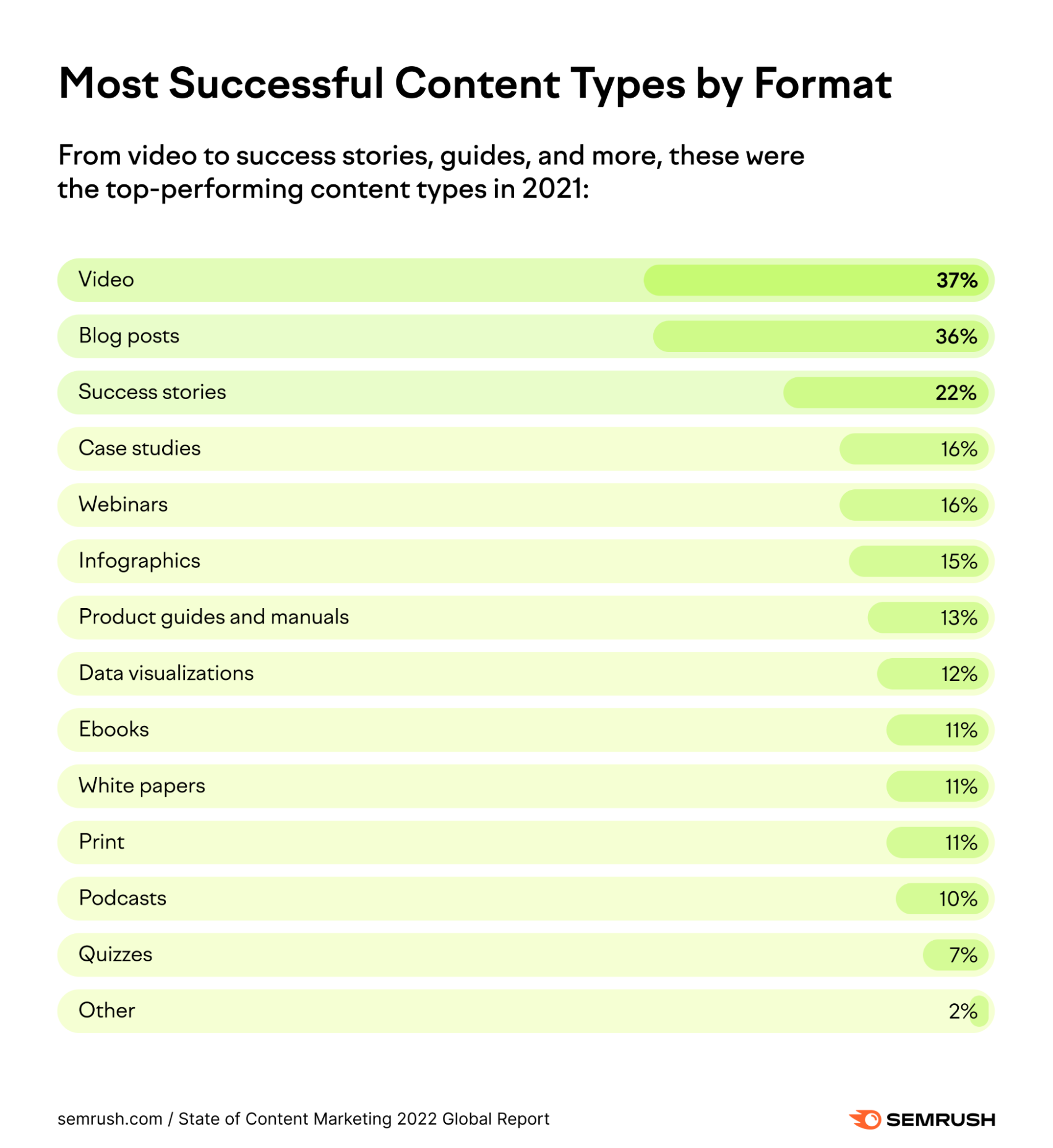
Repurpose Your Content
Once a content piece is published, repurpose it to appeal to new readers who may prefer a different format. Here are some easy ways:
Turn an article into an infographic, slideshow, podcast, or video Segment a long article or video into shorter pieces that you can publish as a series Combine short content pieces to create a white paper or a long-read article Use blog posts to create usable snippets and informative images for social mediaTake Advantage of User-Generated Content
Include user-generated content (UGC) in your narrative to help grow your reputation with your audience. Reviews, comments, photos, and videos help add legitimacy to your claims. Plus, gathering and sharing this content is easy and saves you plenty of resources.
To illustrate, one of the top content marketing examples we’ve added to our 2022 list includes a powerful UGC element: Apple’s Shot on an iPhone campaign that encouraged iPhone 13 and iPhone 13 Max users to share their photographs using the phone’s macro function.

Step 6: Plan Content Distribution
Creating high-quality, relevant content is essential to succeed in content marketing. However, making sure it reaches the right audience at the right time is equally important. This is where the content distribution strategy comes into play.
As a starting point, try visualizing the media mix. You can see below how owned, earned, and paid media can work together:
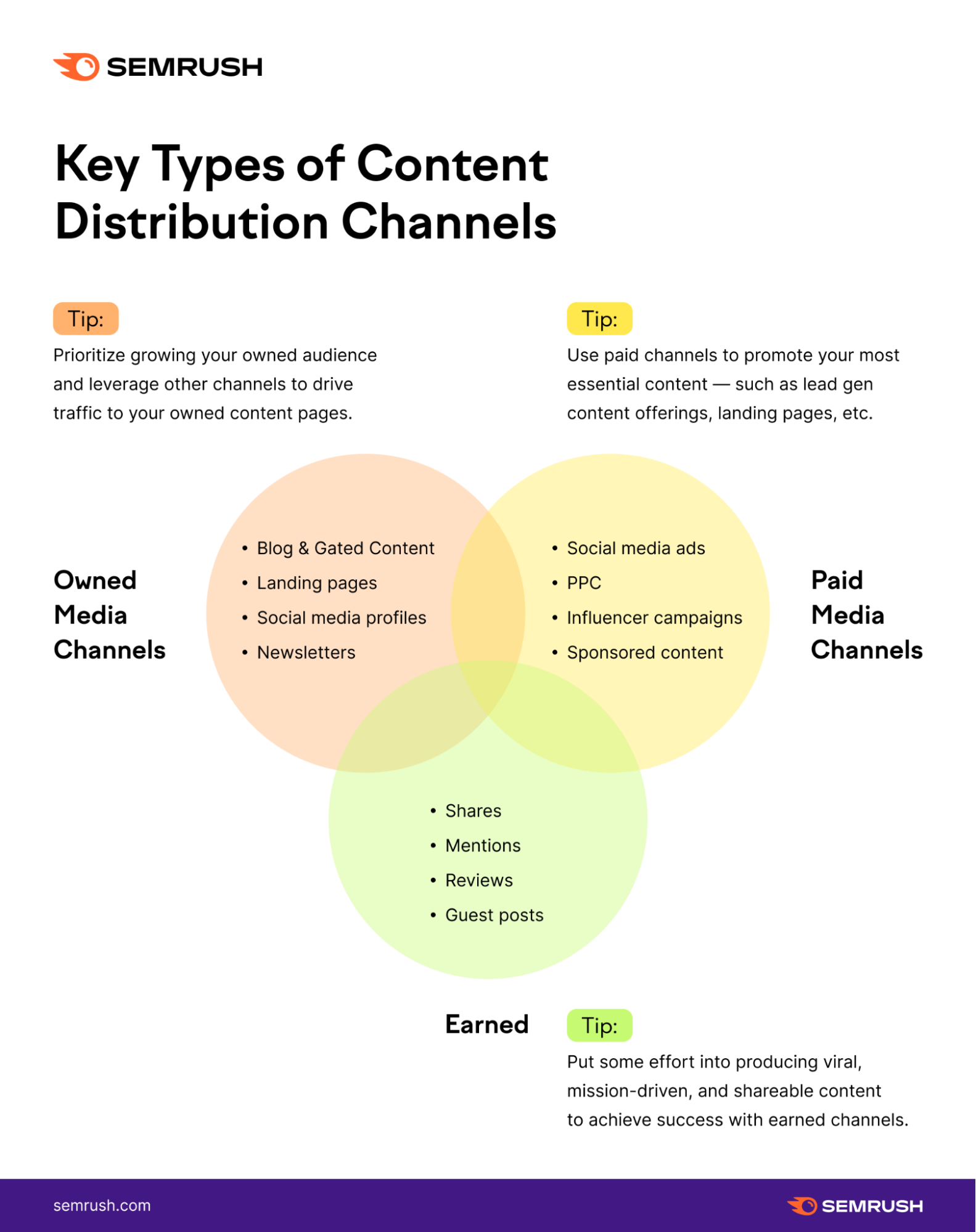
In other words, content distribution is all about using various paid and organic channels to publish and promote your content. When designing your content strategy, list the core channels you will target, analyze their historical performance, and develop ideas on what you can improve.
Besides, exploring new channels is always a good idea. For instance, do you feel like you are fully leveraging the opportunities brought by influencer marketing and partnerships?
Based on our research, the most popular content distribution channels in 2021 included social media (organic and paid), email marketing, and organic search.
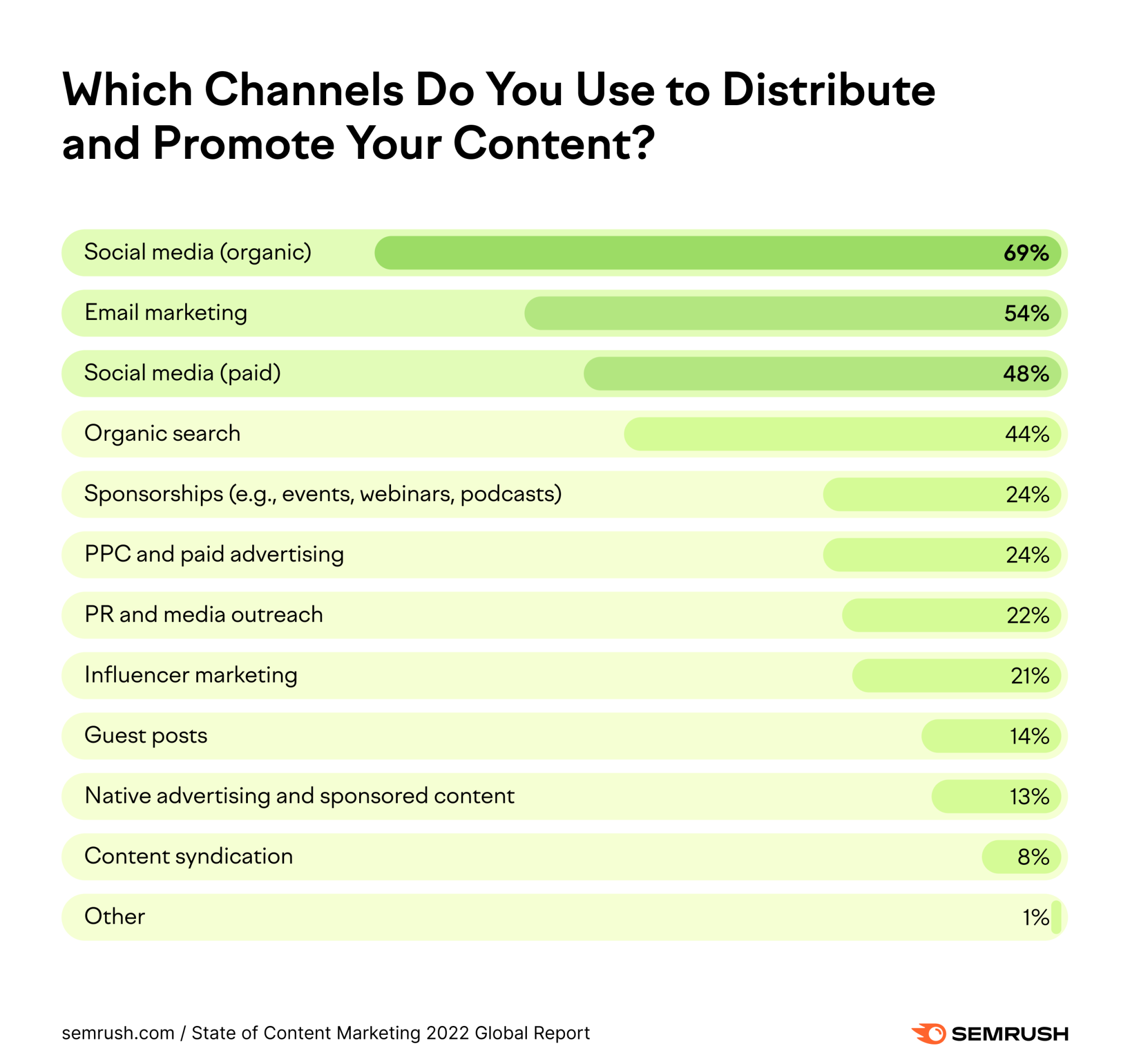
Your resources should go to the channels where your audience already spends most of their time to give your content the best chance of being seen. Your knowledge of the customers and their behavior should determine which channels should be in your mix.
Optimize Your Content for Organic Search
In our recent analysis of 10 selected niche industries, organic traffic accounted for 70-80% of total website traffic in each sector. While ranking is getting more complicated, organic search should still be a crucial part of your content strategy.
To ensure optimal results, prepare to double down on improving content quality and content optimization.
Put simply, content optimization is the practice of ensuring that your text has the best possible chance of achieving its intended goal, whether that’s to rank in a search engine or to turn existing leads into conversions.
The user experience should be your central focus of this process. Think about the following items:
The readability of your text The structure The presence of visuals The tone of voice.Taking care of technical aspects is also essential: e.g., the keyword strategy, interlinking, meta tags, etc.
To automate bits of this process, use the Semrush SEO Writing Assistant—a tool that helps you optimize your content for readers and search engines.
It will assess your copy across four main pillars: readability, SEO, originality, and tone of voice. It will then highlight all bits of texts and elements that need to be improved.
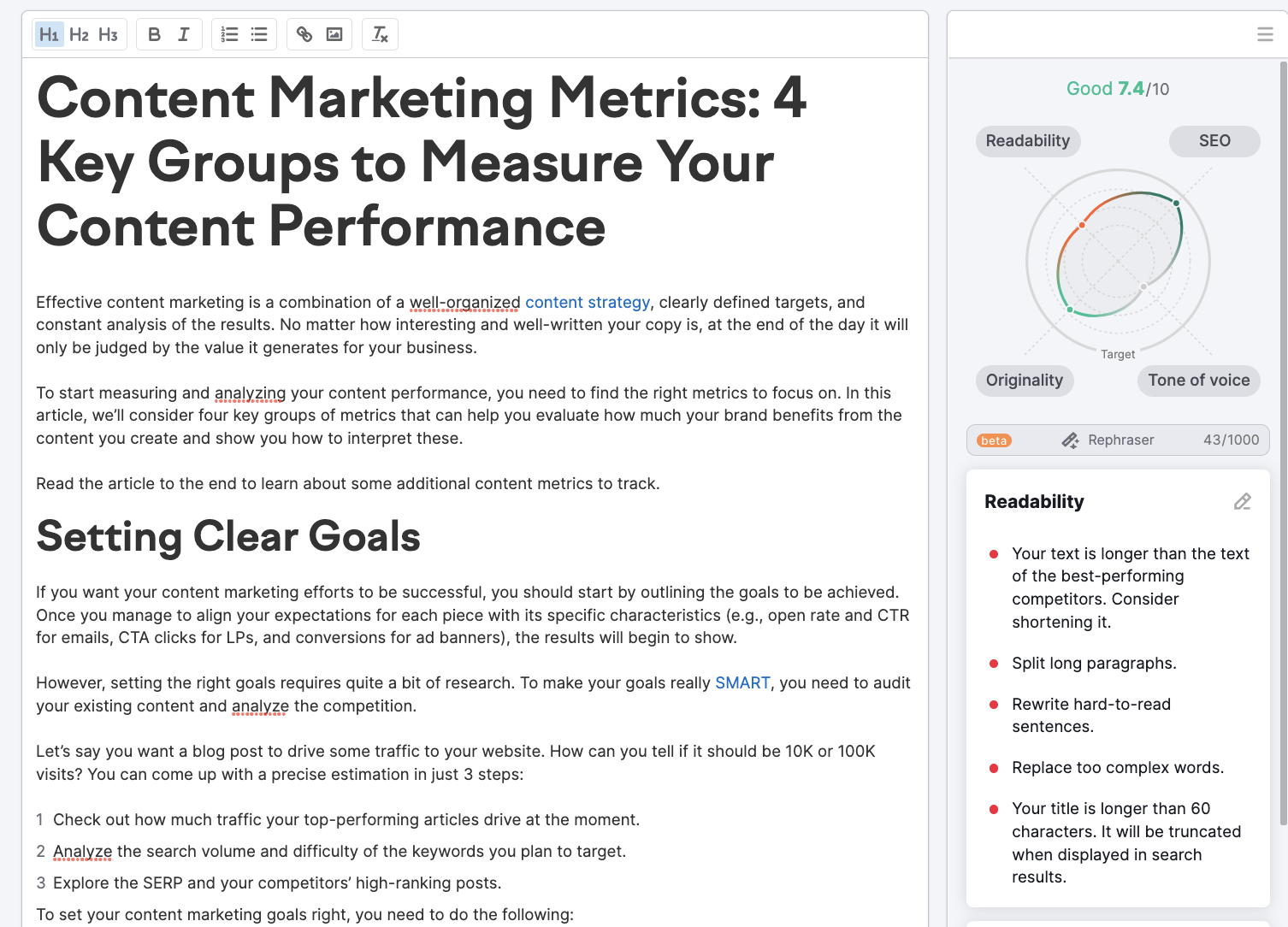 Use the SEO Writing Assistant to automate the content optimization process
Use the SEO Writing Assistant to automate the content optimization processConsider Using Paid Channels
We found out that 46% of companies highly successful in content marketing increased their paid content promo budget in 2021.
There is a good reason for this. Organic content strategies are especially powerful when paired with paid marketing campaigns.
For example, if you see content on a certain topic perform well in search, it might make sense to repurpose it into a lead generation piece and run LinkedIn ads to capture leads.
Multiple content formats are available to promote content via paid channels, from influencer-driven campaigns to sponsored content, lead-generating content ads, and more.
Step 7: Continuously Analyze Your Content Performance
Analyzing your content performance is the best way to understand what content connects with your audience. It also helps you see whether your content marketing efforts are paying off.
According to our research, in 2022 only 66% of marketers analyze their content’s performance regularly.
Here is how you can do it:
Set up your analytics: you can start with using Google Analytics to see and Semrush's Position Tracking tool Always refer to the primary, high-level content marketing goals you've established for your content strategy. For example, you can track whether you are reaching your annual revenue target by analyzing the overall performance quarterly. Set specific KPIs for every content piece and measure them during the content audit processBelow are the four essential content marketing groups of metrics you can track:
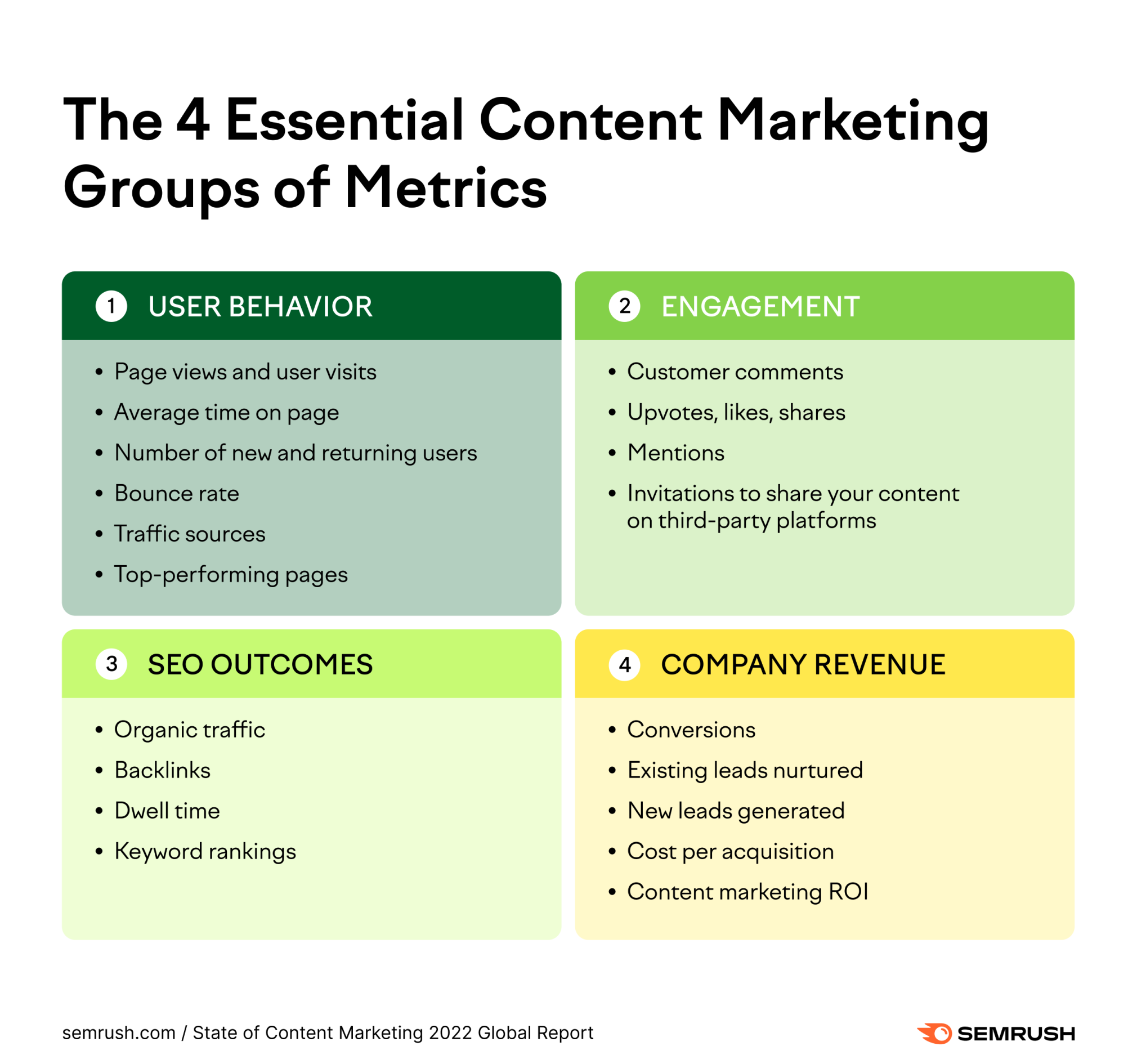
Master Your Content Marketing Strategy
While the methods used to deliver content to prospects are continually changing, the core principles remain the same—developing a top-notch content marketing strategy based on customer empathy and trustworthy data.
Even if you are just getting started, don’t get intimidated by the process. Keep moving at the optimal pace. For questions specific to the early stages of the business, have a look at our definitive guide to content marketing for startups.
As you progress in your content marketing efforts, you will find that automating different pieces of your content workflow and enriching them with data allows you to outsmart the competition. In that case, Semrush’s Content Marketing Platform might help you sustain and double your company’s organic growth.
Innovative SEO services
SEO is a patience game; no secret there. We`ll work with you to develop a Search strategy focused on producing increased traffic rankings in as early as 3-months.
A proven Allinclusive. SEO services for measuring, executing, and optimizing for Search Engine success. We say what we do and do what we say.
Our company as Semrush Agency Partner has designed a search engine optimization service that is both ethical and result-driven. We use the latest tools, strategies, and trends to help you move up in the search engines for the right keywords to get noticed by the right audience.
Today, you can schedule a Discovery call with us about your company needs.
Source:





